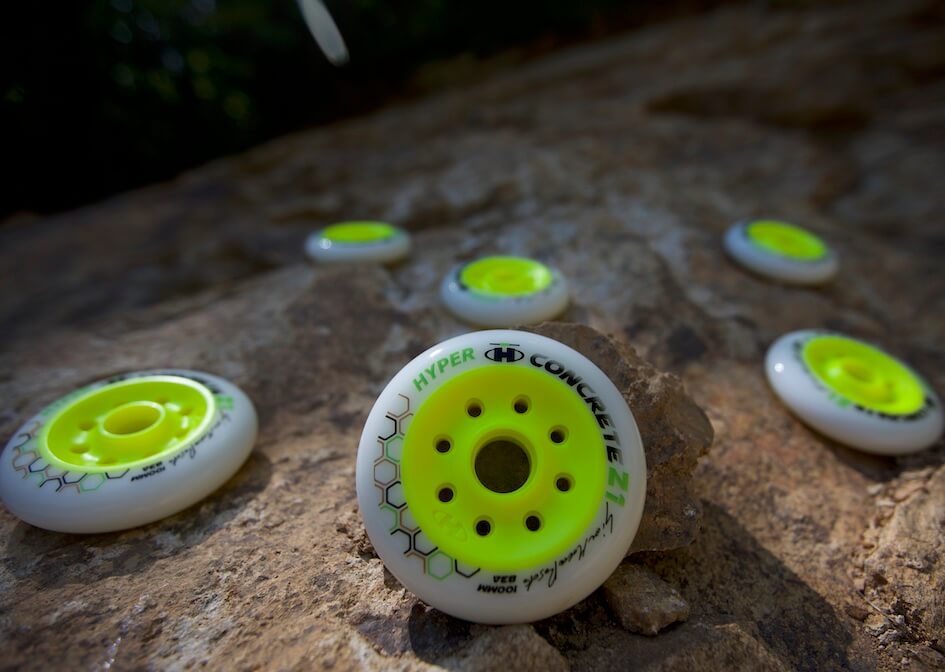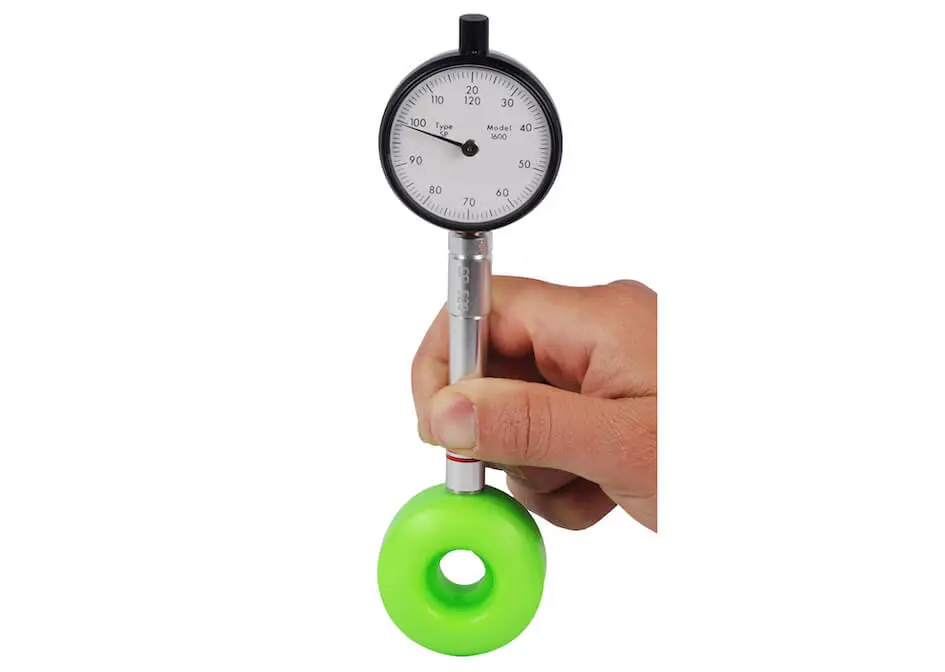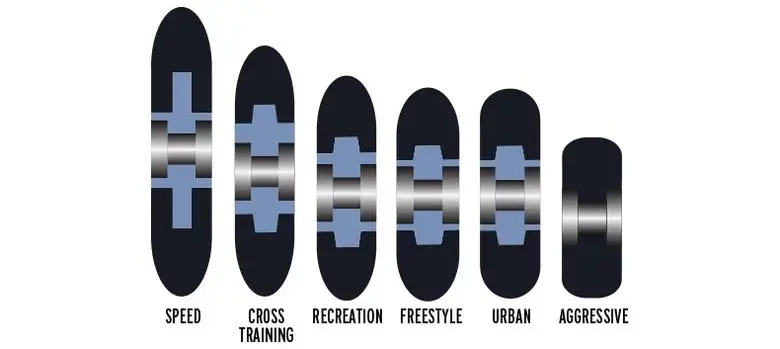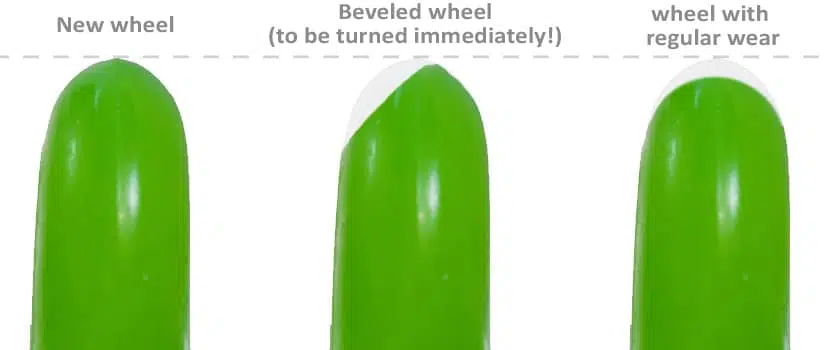Wheel terms explained

- Durometer: The durometer is a righteousness gauge of the wheel, the average value usually in ratios along with which "A" is written. The higher the number, the less likely the wheel is to be flattened. The hard places are generally more sustainable and are more conducive for smoother rides on flatter surfaces. Furthermore, the softer wheels are a bit more bumpy and more support traction to them, they are better for cutting rougher terrains.
- Diameter: The diameter of the wheel is the width of it from side to side, a linear measure in millimeters. The circumference of the wheel has an influence on speed as well as it is moved across one edge to another in a number of ways. By and large, faster and smoother rides are the most prominent features of the large size wheels used in long-distance rides since inertia is higher. However, a smaller wheel is fit for the purposes of giving one more force and the required flexibility to perform tricks, freestyle skating.
- Width: The wheel width is the distance between the two opposite edges. Wider wheels induce more cruise control, which is very beneficial and hence preferred by beginners or skaters who need a steadier ride. Skates with a narrow gauge result in a car that can turn easier and move in a straight line, which is the ultimate adaption for professional skaters that perform quick turns or cruise spaces where the pitch is very small.
- Profile: The profile of the wheel refers to the shape of the wheel. The next inclusions tend to be round, flat, and out of shape. The round wheels are a bit more flexible and are commonly used for skating. Thinner wheels are less round at the inner part than the outer ones that make them provide more friction and thus remain firmly on the surface, which is mainly used for the sake of training inside and for the purpose of performances where human talents are also involved. Bullet-shaped wheels are usually have a bigger contact patch, which guarantees more contact and hence stability.
- Core: The core is the center part of the wheel, which is the part where the bearings are located. There are solid cores that offer more stability and control because of which such a skate is an ideal first set up for the beginner skater and those who like a smoother ride. The lighter hollow cores give a skater speed and acceleration because of their lighter nature, they are ideal for more advanced skaters.
- Bearing seat: The bearing seat is the part of the wheel that holds the bearings. The bearing seat affects the performance of the wheel by influencing how the bearing spins and how fast it can go. A well-designed bearing seat can help reduce friction and improve overall speed.
- Hub: The hub is the outer part of the wheel that connects to the bearing. Hubs can be solid or spoked, and can affect the weight and stability of the wheel. Solid hubs, on the other hand, stand out when a skateboarder's speed is of prime importance. Moreover, they are good for novices and for owners who prefer stability. Spoked hubs, meanwhile, enable skateboards to be much lighter and provide a higher amount of speed, which is why they are more suitable for advanced skaters.
Wheel Diameter
Another factor to consider when buying inline skate wheels is the diameter of the wheel. Though wheel diameters can go from 68mm to 125mm, most of them fall between the 72mm and 84mm range. The wheel size will also affect your speed and agility. This is because larger wheels provide a higher top-end speed and smooth glide over rough surfaces than smaller wheels do, so they are better for outdoor and distance skating. Smaller wheels allow better control on tricks and for freestyle skating. Wheel diameter choice depends on skating type, personal preference, and skill level.

Durometer wheels
A durometer, or merely a device that is used to measure the hardness of a material, gives the rating. It also affects performance in various skating conditions. Ordinarily, a durometer is measured either on a scale of 0 to 100 and then marked by a number on a scale and then followed by the letter "A". Some of the common durometers for inline skate wheels are between 72A and 90A; however, the most popular are 78A and 82A durometers.
The softer wheels are the durometer rating, usually 72A or 76A; they're much more shock-absorbent and give a smoother ride on rougher surfaces. These are great for outdoor skating, especially on natural rough surfaces, as they offer better grip and control. However, they wear down faster than their harder counterparts and are slower.
Harder wheels, in a higher durometer—84A or 90A—signify durability with better speed attained on flat ground. They would be most effectively used for indoor skating, mostly on wooden or concrete floors, since they roll more and slide less. On the other hand, they would be less comfortable on any rough surface and—owing to their possible lack of elasticity—offer reduced shock absorption.
It is strongly important to get the right durometer rating for what you are trying to do on a skateboard and the surfaces you will be skating on. If not, you really just have to give some different durometer ratings a go and see which one fits for your style and preference.
Wheel rebound
Rebound, in relation to wheels, is the term for the regain of the spring effect when it springs back to its original position after pressure is applied. One of the most important factors to consider when selecting a wheel is the size of the wheel; all other features can be linked back to it either directly or indirectly. For instance, one might be concerned that a borrowed size of wheel could delete the hub of the kit.
As opposed to other wheel parts, a wheel when it is pushed against the curb or another hard material, will momentarily deforms a bit. A wheel rebound ability that is high will be just moments it is squished and go back to the original position to continue rolling with the same speed and loss of energy. Thus skaters can maintain a constant speed using the minimum amount of energy. If a wheel has more rolling resistance then it will take the skater more effort to skate as the wheel will not be rolling as easily as it should be if it has better rebound.
A bad rebound, however, can result in a wheel's inability to be re-erected to its normal size and shape immediately. Therefore, this results in less speed, balance, and control for the skater. Similar to this the wheel could create more vibrations which make the ride very uncomfortable - it virtually feels like the whole body is vibrating. Clearly, the mere bouncing back of a wheel also can depend on material differences: the material type determines the restored shape, while the wheel's size and shape contribute the most to the rebound.
A high or low recovery rate will be influenced by the materials and the specific design of the wheel. Moreover, if we use a softie wheel rather than a hard one, we can change the number of rebounds we get, as this wheel gives more rebounds due to its ability to disform with ease. On the other hand, if it is observed carefully the effect of wheel becomes more apparent because it not only makes the ride more stable but also absorbs a larger quantity of the impacts.
Since the wheel's mechanical rebound is far from the only condition, personal taste, the skater's own particular style of skating, and surface characteristics should also be taken into account. For the most part, people are, of course, quite apt to prefer a bouncier wheel that they consider to be the smoother one, but sometimes they may want a wheel with less rebound to give them more control over their movements as well as a faster response.
Wheel grip
Wheel grip is the ability of the skate wheel to keep in touch with the floor of the skate park, thus giving stability and control to the skaters. Thus, in other words, it is the wheel's ability to hold on the surface on which it is rotating and keep the skater from either sliding or losing balance.
The level of traction which is secured by a skate wheel can be induced by a lot of factors, including wheel hardness, size, shape, and surface texture. A hard wheel can, in this case, be less logarithmic than a soft wheel, be it in sliding or skidding. In fact, because harder wheels have less ease than softer wheels they can be skid on smooth surfaces more often. As a result, a soft wheel can be gripper, but it can also be the wheel that wears out most quickly.
The wheels' dimensions and their design also have a part in this, where longer and wider wheels provide great stability and control. Besides, some wheel configurations, for example, the flat or square ones, have a greater area of pavement contact than the curved ones and thus more traction.
Surface texture in the work wheel can also move the grip of the wheel. For example, a hard indoor skating rink with ultra high grip wheels may be less grippy, due to the fact that the wheels can roll smoother and faster. Alternatively, uneven outdoor surfaces need wheels, which have more grip to keep control and avoid skiing.
On the whole, grip is the main concern in the selection of wheels as it is the one thing that will determine safety and the best experience. Skaters should have in mind their personal preferences regarding their style, as well as, what surface will they skate when making decisions about the wheels that they will use.

Wheel profile
Wheel profile in a skates is the shape of the wheels, which includes the width of the wheels and the curvature of the edges. The wheel profile can affect several of skating features – speed, stability, and maneuverability.
Generally, there are two main types of wheel profiles: rounded and flat. Rounded wheels are circular-shaped, with a wider section in the center and narrower edges. It is a profile that is mostly used for outdoor skating and cruising, as it gives the skater a soft ride and lets him/her overcome obstacles effortlessly. Rounded wheels may still be less stable and difficult to control than flat wheels especially at higher speeds or making sharp turns.
On the other hand, flat wheels are squared with straight corners. This type of profile is generally preferred for indoor skating and aggressive skating, as it provides more stability and control during complex maneuvers and at higher speeds. Flat wheels will also have a better grip and will respond better than rounded wheels especially on smooth surfaces.
Wheel profile is also a factor that can change the size of the wheel's contact patch. That is, the part of the wheel that makes contact with the skating surface. A wider contact patch allows for more grip and stability, while a narrower contact patch enables more speed and maneuverability. Some wheel profiles are designed to make good contact patch for better grip and stability, while others are designed to make small contact patch so that the make speed and agility maximize.
In general, the correct decision as regards to the type of wheel profile to be chosen for one's skating will be dependent on factors such the way one skates, the kind of skating he/she would do and of course one's personal tastes for fastness, stability, and maneuverability.

Wheel wear
Wheel wear is an inevitable outcome that takes place when the wheels of inline skates are utilized and consequently touch down on various surfaces. Along with the wheels wearing out, they also suffer from the presence of flat spots which ultimatelygravely influence your skating.
Hardness of a wheel is one of the main factors but it can also be a cause of wheel wearing off Hard solid wheels usually last much longer, but they can also be an attribute to the wearing of the wheel in a larger quantity, thus flat spots are formed. Softer wheels, on the other hand, while they could wear much faster would also be the ones that absorb shock better and grip better.
Surface type is another significant component when discussing wheel wear. Coarse or uneven surfaces, for example, asphalt or concrete may create a greater. amount of wear and tear in the wheels in comparison with smoother surfaces like indoor skating rinks. Also, skating on the wet or throughgravel and dirt. can make the wheel wear out faster.
In the attempt to lengthen the lifespan of the inline skates and to reduce the wear and tear, a thorough and proper treatment needs to be applied. Part of the way you can do this is to lie ensure that the wheels are regularly cleaned, inspected for the evidence of any damage, and rotated to provide wear uniformity. It is crucial to select the right sets of wheels that match the particular form of the skating style and the surfaces engaged in.
In summary, wheel wear is a standard part of using inline skates and it can degrade your skating performance as time goes on. By taking good care of the wheels and checking out when you need to replace parts as well, you can prolong the life of your wheels thus having a more positive and enjoyable skating experience.
Wheel hub
In the field of inline skating, the wheel hub refers to the middle of the wheel, which connects the wheel to the skate frame's axle. One of the various significant impacts a hub can have is on the speed, stability, and the wheel models' shock absorption.
Inline skate wheel hubs have different designs and the same is followed: each of them has its pros and cons. A hub of great dimension, as an instance, can show better stability and the rider can control it more effectively, particularly when the speed is high. However, a large hub might also add more weight and less maneuverability to the wheel.
Another type, that of the small hub, can downsize the wheel and at the same time, fuel the speed of your skate since there is less contact with the ground, whereas it can also become weaker and make its ability of absorbing the impact of hard landings worse. There are some wheels that also come with holes or other attributes that let the wheels lose some weight and also keep the wheels stay robust yet flexible.
Besides the role that wheels play in skating performance, hubs can also be a factor that affects compatibility among wheels and skate frames. Various skate frames may have axles of different sizes or hub spacing, the last of them determining the type of wheels that fit the skates they come with.
Naturally, which hub is the best for your inline skates and depends on your preferences and the activities you are involved in. The skater should analyze the scope, design, and type of wheels he wants to buy before their frame, therefore the compatibility of specific hubs with their skate frames will be the parameters that will help them pick wheels with the perfect hub for their requirements.
Wheel weight
It is the amount of weight any given wheel adds to the skate. Wheel weight plays a very important role in skating performance, and it relates directly to speed, acceleration, maneuverability, and overall agility.
Lighter wheels provide better performance on speed- and agility-related events, including freestyle and slalom skating. Lighter wheels, however, will yield less stability at high speed and less shock absorption compared with heavier wheels; hence, such activities are not much suited for downhill skating or aggressive skating.
On the other hand, heavier wheels may be suitable for speed skating or long distance skating because of their relatively higher stability and shock absorbance. However, heavier wheels also become difficult to maneuver and require a lot of effort to accelerate; hence, they are not appropriate in fast-turning and complicated maneuvers.
Additionally, the weight of the wheel makes a difference in the overall weight of the skate, which impacts the comfort and endurance of the skater. If the wheels of the skates are heavier, then they become bulky to be carried about for use over a long time. In contrast, lighter wheels make them easier to use for extended periods without resulting in fatigue.
The correct weight of the wheel for inline skating greatly depends on the type of skating, style of skating, and above all, personal preference. To achieve the appropriate weight for the wheels, skaters have to consider their weight in opposition to other skating equipment and their physical attributes, together with the kind of skating one intends to do.
